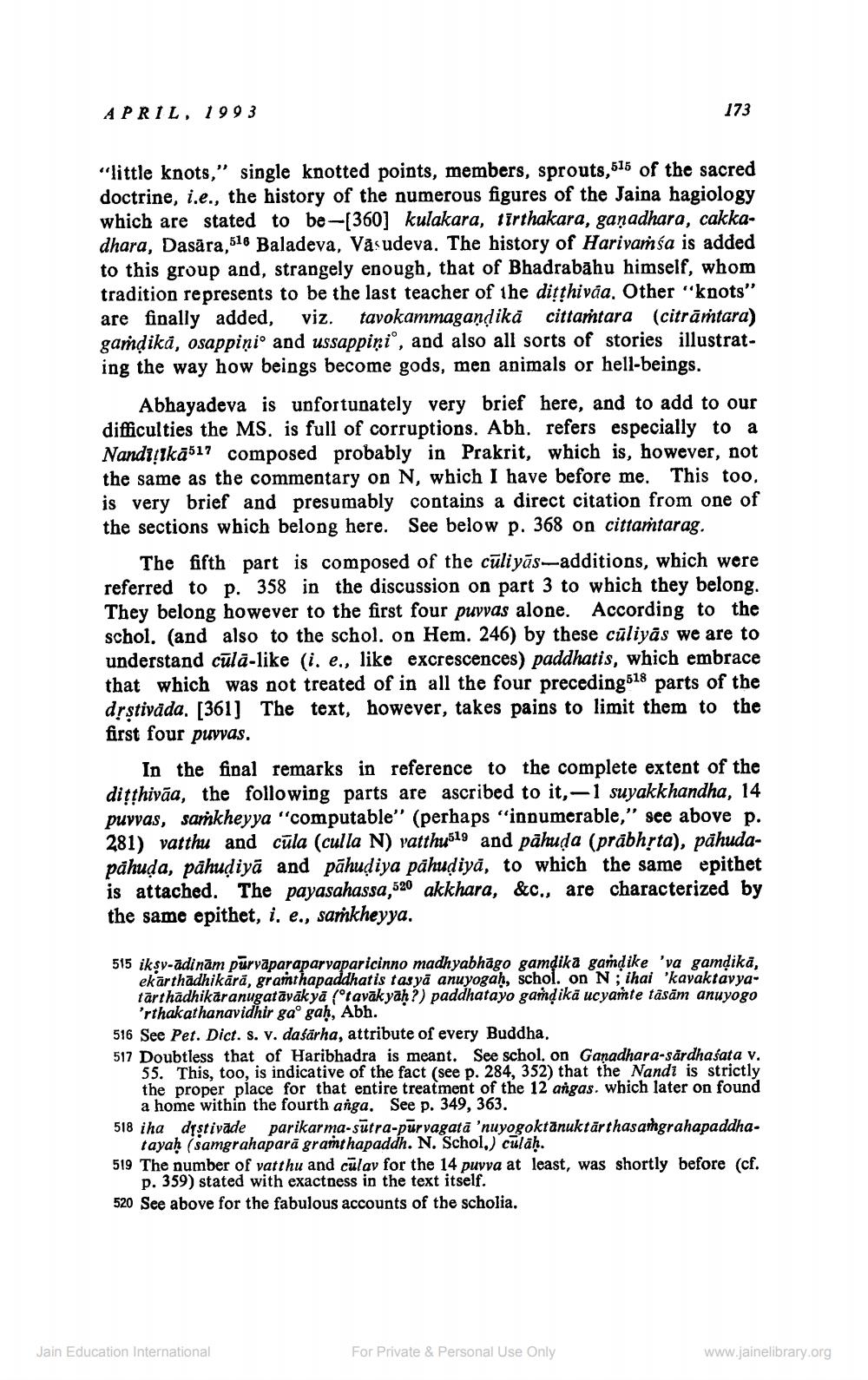________________
APRIL, 1993
173
“little knots," single knotted points, members, sprouts,515 of the sacred doctrine, i.e., the history of the numerous figures of the Jaina hagiology which are stated to be-(360] kulakara, tirthakara, gañadhara, cakkadhara, Dasära,516 Baladeva, Vasudeva. The history of Harivaṁsa is added to this group and, strangely enough, that of Bhadrabahu himself, whom tradition represents to be the last teacher of the ditthivåa. Other "knots" are finally added, viz. tavokammagandikā cittastara (citrāṁtara) gaṁdika, osappini' and ussappiņi', and also all sorts of stories illustrating the way how beings become gods, men animals or hell-beings.
Abhayadeva is unfortunately very brief here, and to add to our difficulties the MS. is full of corruptions. Abh. refers especially to a Nandiskā517 composed probably in Prakrit, which is, however, not the same as the commentary on N, which I have before me. This too, is very brief and presumably contains a direct citation from one of the sections which belong here. See below p. 368 on cittaṁtarag.
The fifth part is composed of the cūliyās--additions, which were referred to p. 358 in the discussion on part 3 to which they belong. They belong however to the first four puvvas alone. According to the schol. (and also to the schol. on Hem. 246) by these cūliyās we are to understand cūla-like (i. e., like excrescences) paddhatis, which embrace that which was not treated of in all the four preceding518 parts of the drstivada. [361] The text, however, takes pains to limit them to the first four puvvas.
In the final remarks in reference to the complete extent of the ditthivāa, the following parts are ascribed to it,-1 suyakkhandha, 14 puvvas, samkheyya "computable” (perhaps "innumerable," see above p. 281) vatthu and cūla (culla N) vatthusle and pāhuda (prabhṛta), pähudapåhuda, pähudiyā and pāhudiya pähudiya, to which the same epithet is attached. The payasahassa,520 akkhara, &c., are characterized by the same epithet, i, e., sarkheyya.
515 ik şv-ādinām purvāparaparvaparicinno madhyabhāgo gamdika gandike 'va gamdikā,
ekārthadhikarā, granthapaddhatis tasyā anuyogah, schol. on N; ihai kayaktavyatarthādhikaranugatāvāk yā (tavāk yah?) paddhatayo gaṁdikā ucyařte tāsām anuyogo
'rthakathanavidhir gao gah, Abh. 516 See Pet. Dict. S. v. dasärha, attribute of every Buddha. 517 Doubtless that of Haribhadra is meant. See schol. on Ganadhara-särdhasata v.
55. This, too, is indicative of the fact (see p. 284, 352) that the Nandi is strictly the proper place for that entire treatment of the 12 angas, which later on found
a home within the fourth anga. See p. 349, 363. 518 iha dystivāde parikarma-sutra-purvagatā 'nuyogoktänuktārthasangrahapaddha
tayah (samgrahaparā granthapaddh. N. Schol.) culāh. 519 The number of vatthu and cülay for the 14 puvva at least, was shortly before (cf.
p. 359) stated with exactness in the text itself. 520 See above for the fabulous accounts of the scholia,
Jain Education International
For Private & Personal Use Only
www.jainelibrary.org




